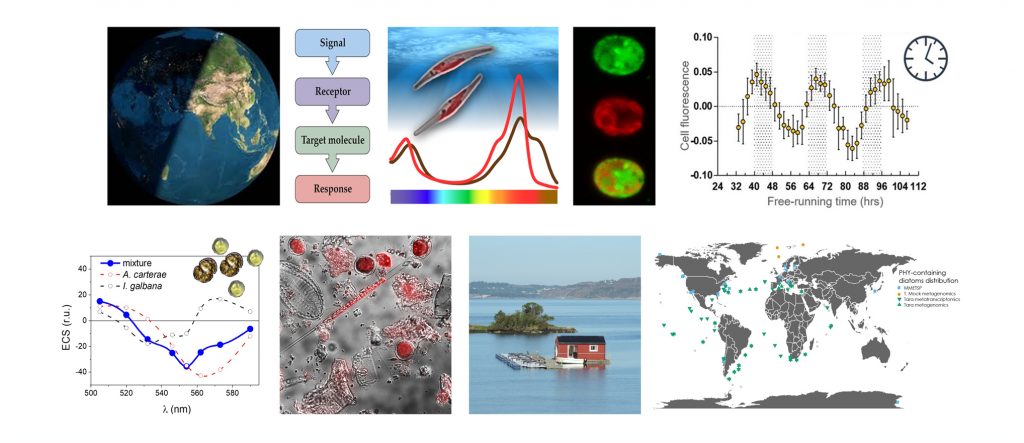 Aim of this research is to improve our understanding of the complex interactions between microalgae and their environment. In particular, we investigate specific physiological responses to different abiotic signals and stresses of relevance (e.g., light, dark, photoperiods, nutrients) for diatoms and Chlamydomonas, as well as the impact of different biotic signals derived by other organisms (microalgae, viruses and bacteria), by merging laboratory and in situ studies. Recent progress in algal genomics and genetics (Theme 6), combined with well- established (eco)physiological and biophysical approaches (Theme 1) provide novel opportunities to address these questions. Our collaboration with the Tara’s Ocean consortium and the Roscoff Biological Station (SBR, France) permit a deeper exploration of photosynthesis and light-sensing processes in a functional global marine ecosystem.
Aim of this research is to improve our understanding of the complex interactions between microalgae and their environment. In particular, we investigate specific physiological responses to different abiotic signals and stresses of relevance (e.g., light, dark, photoperiods, nutrients) for diatoms and Chlamydomonas, as well as the impact of different biotic signals derived by other organisms (microalgae, viruses and bacteria), by merging laboratory and in situ studies. Recent progress in algal genomics and genetics (Theme 6), combined with well- established (eco)physiological and biophysical approaches (Theme 1) provide novel opportunities to address these questions. Our collaboration with the Tara’s Ocean consortium and the Roscoff Biological Station (SBR, France) permit a deeper exploration of photosynthesis and light-sensing processes in a functional global marine ecosystem.
Specific topics covered by our research include:
1) The characterization of diatom photoreceptors, their signaling pathways and their function in vivo
2) The study of light regulated rhythmic processes and circadian clock in diatoms
3) The remodelling of thylakoid membrane proteins upon nutriment starvation in C. reinhardtii
4) Photosynthesis and biotic interactions
5) Photosynthesis in the field
Selected references :
- Annunziata R , Ritter A , Fortunato A E, Manzotti A, Cheminant-Navarro S, Agier N, Huysman M J J, Winge P, Bones A, Bouget F-Y, Cosentino Lagomarsino M, Bouly J-P, Falciatore A (2019) The bHLH-PAS protein RITMO1 regulates diel biological rhythms in the marine diatom Phaeodactylum tricornutum. PNAS, in press
- Jaubert M, Bouly JP, Ribera d’Alcalà M, Falciatore A (2017) Light sensing and responses in marine microalgae. Curr Opin Plant Biol, 37:70-77.
- Fortunato A E, Jaubert M, Enomoto G, Bouly J-P, Raniello R, Thaler M, Malviya S, Bernardes J S, Rappaport F, Gentili B, Huysman M J, Carbone A, Bowler C, d’Alcalà M R, Ikeuchi M, Falciatore A (2016) Diatom Phytochromes Reveal the Existence of Far-Red-Light-Based Sensing in the Ocean, Plant Cell, 28(3):616-28.
